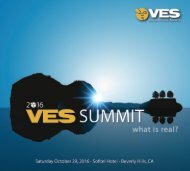Create successful ePaper yourself
Turn your PDF publications into a flip-book with our unique Google optimized e-Paper software.
six 9’ x 9’ pods that held one person at a time for a personal immersive<br />
experience. “We go to great lengths to consider the audience,”<br />
continues Spiteri. “VR is a powerful medium and you can instill a<br />
high degree of empathy and can also scare people easily. We aim for<br />
the right level of awe. No cheap scares. No shark jumps out at you.”<br />
Rowell adds, “Exploration is the heart of what ‘theBlu’ is.” Meeting<br />
a full-sized whale, even virtually, is awesome. “The creature<br />
acknowledges you’re there and they’re there. The connection is<br />
very powerful.”<br />
According to Spiteri, reactive sea anemones and bioluminescent<br />
creatures are possible because, “It’s a combination of software,<br />
custom development of code and algorithms, and creating<br />
a simulation engine that determines how the fish move and<br />
swim.” Explains Rowell, “‘TheBlu’ code base lives in Unity – the<br />
rendering engine. It’s flexible and customizable and can achieve<br />
many different looks. We set a series of ‘go-to’ points in the story.<br />
Some parts are scripted, but the ocean still needs to feel alive and<br />
random.” Art is also critical, and the work of Academy Awardwinning<br />
visual effects artist Andy Jones was key.<br />
The Museum of Science, Boston has taken a deep dive into tech<br />
in order to excite visitors and inspire life-long learning. “Particle<br />
Mirror” opened this year, and inculcates an interest in physics.<br />
Kids and adults alike gambol in a snowstorm, bounce giant colorful<br />
orbs and frolic through pixie dust – and nothing is real.<br />
Created by Karl Sims, a digital media artist, computer scientist,<br />
and recipient of a MacArthur Fellowship, the wall-sized virtual<br />
mirror uses a Microsoft XBox One Kinect Depth Sensor camera to<br />
capture visitors’ motions and depth and project them into the AR<br />
environment. Sims, who previously founded software company<br />
GenArts, developed the systems for “Particle Mirror” using C,<br />
OpenGL and Open CL, which runs on a Linux computer with an<br />
NVIDIA GTX 1080 graphics card. Participants are led through<br />
a series of nine revolving scenarios, interacting with a changing<br />
variety of dots and spots, all following the laws of physics and the<br />
properties programmed into each. Gravity causes “snow” to fall<br />
from the top of the screens – and, just like real snow, it collects on<br />
heads and shoulders, and can be scooped into snowballs. Music<br />
enhances the magic – when particles collide different sounds<br />
are generated. “The bubbly effect makes bubbly sounds. They<br />
gurgle when pushed,” Sims explains. “The goal is to inspire kids<br />
to learn more.”<br />
The museum also houses Sims’s “Reaction-Diffusion Media<br />
Wall,” installed in 2016. He details that the exhibit simulates “two<br />
chemicals that make emergent dynamic patterns.” Consumers<br />
at a kiosk manipulate patterns projected on 24 hi-def screens.<br />
To create the effects, Sims used a consumer-gaming piece of<br />
hardware: a graphics processor on Linux machine with 2000<br />
processing cores and 11 processing GPU.<br />
Museum of Science, Boston develops most things in-house with<br />
a dedicated nine or 10-person team, including a 3D designer, a<br />
physical manipulative engineer, software developers and builders.<br />
According to VP of Exhibition Development Christine Reich,<br />
special effects excite and engage people in learning. “Neuroscience<br />
is now teaching us that emotions are the starting point for<br />
TOP and BOTTOM: “Particle Mirror” is now on display at the Museum of<br />
Science, Boston. Participants are led through nine revolving scenarios,<br />
interacting with a changing variety of dots and spots, all following<br />
the laws of physics. In the “snow” simulation, visitors collect the<br />
falling particles, toss them around, or sweep them off the floor as they<br />
accumulate. In the “blue sparks” simulation, a “trails” effect makes the<br />
“sparks” look like they’re swimming through swirling liquid. Particles<br />
generate different musical chords when pushed. (Photos courtesy of I/O)<br />
FALL <strong>2017</strong> <strong>VFX</strong>VOICE.COM • 9




